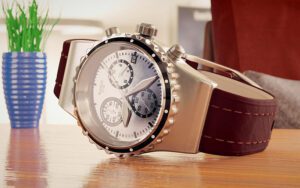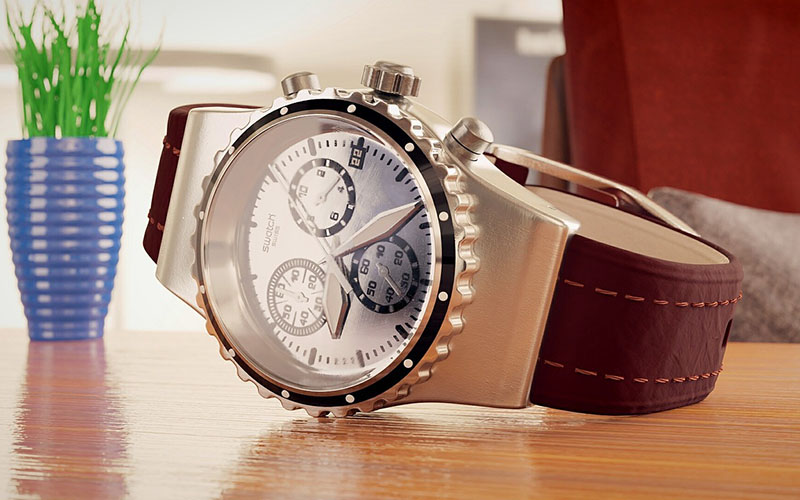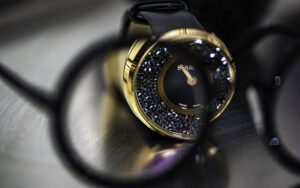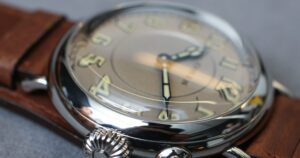The 80s gave us bold colors and big hair, the Care Bears and Cabbage Patch dolls. However, for watch repair and other horology gurus, the decade’s most outstanding contribution was the Swatch. Short for ‘second watch,’ the timeless icon splashed onto the world stage just under 40 years ago as a stylish, inexpensive quartz option for those who still wanted Swiss-made without the high price tag.
The Swatch watch represented a sorely-needed renaissance for the Swiss watch industry after it was devastated by the advent of the quartz movement in 1969, otherwise known as the Quartz Crisis. Inexpensively-made Japanese quartz watches quickly took the market by storm, threatening to all but extinguish the expensive mechanical movements for which Swiss giants like Rolex, Omega, and Cartier were known. By the early 80s, Swiss watchmakers’ global market share had shrunk to 20 percent, and many manufacturers faced the real possibility of having to shutter their operations for good.

Enter Nicolas Hayek
Initially hired as a consultant to save the Swiss industry from collapse, he eventually created and led the highly-successful Swatch Group, a union of 18 major players including Omega, Blancpain, and Rado.
For years, Swiss watches have been singled out for their accuracy, reliability, and iconic reputation. When quartz arrived, two of those home-field advantages – accuracy and reliability – evaporated overnight. The Japanese could build timepieces that were just as accurate and reliable but cheaper and faster.
Hayek knew the Swiss watch industry needed an immediate reset, or any hope of competing would soon be gone. After consolidating companies and streamlining manufacturing processes to better satisfy consumer demand, Hayek pressed forward to develop a new brand of watch that could compete with the Japanese in terms of accuracy, reliability, and low-cost manufacture. Unlike its Asian competitors, however, this watch would come with centuries of Swiss street cred.
Many Swiss felt that Hayek was crazy for creating the Swatch. The Japanese and Chinese manufacturers seemed to have the low-end segment of the watch market all locked up. Some also felt competing at that price point would cheapen the Swiss brand. Would a Swiss reputation alone be enough to carry a lower-end watch successfully? There was only one way to find out. In 1983, with only 51 parts and a bold design, the mass-produced Swatch hit the quartz market like an earthquake.
The gamble paid off in spades. About a million Swatch watches sold during its first year, and hundreds of millions of watches have sold since. Today, the price for a new Swatch ranges anywhere from $40 to more than $200, while some vintage Swatches can sell for thousands of dollars. With hundreds of different designs, from the transparent Clear Gent to Peanuts-themed to create your own, there’s a Swatch for virtually every personal style or taste.
The Secret to Swatch Success
In 1993, Hayek said in an interview with the Harvard Business Review that several elements contributed to Swatch’s overnight success, including its high-quality and low-cost, provocative designs, and a sense of playfulness and joy. “Ultimately, we are not just offering watches. We are offering our personal culture,” Hayek said. Swatch was, and is, all about joie de vivre. How do you feel when you wear a Swatch? Enough said.
The central idea behind labeling the Swatch as a ‘second watch’ was that you want to wear different watches for different occasions. To do that, you need more than one watch. Popular ads with stars like Lauren Hutton and the Thompson Twins wearing several Swatches on each wrist sold the idea that the more Swatches you owned, the cooler you are. Going out? Maybe a traditional black Swatch. Feeling whimsical? Try the Hippo Lovers Swatch. Or, simply wear all five of your watches at the same time. “Life should be an adventure,” according to an original Swatch catchphrase.
If you’re anything like me, you may still have one or two stuffed in a box somewhere alongside your parachute pants and Sony Walkman. Don’t fret if it’s a little worn or even if it doesn’t work. You can send your vintage piece to our Swiss-trained repair technicians. We can repair Citizen watches, Rolex, Swatch, and everything in between. We can have your aging Swatch out the door looking as good and acting as functional as the day it was purchased. You might even be surprised to learn that your old Swatch may be worth something once it’s operational again. Even if it hasn’t increased in value, though, consider yourself lucky to be wearing a fun piece of history.
A New Crisis – The Smart Watch
Not surprisingly, today’s main competitors for Swatch watches are Japanese biggies like Casio and Citizen, India’s Titan Company, and Chinese newcomer AliExpress. However, the Apple Watch has emerged as the major threat to the watch industry as a whole, especially Swiss watches. Currently, Apple watches outstrip the entire Swiss sector in sales every year, and market analysts expect that trend to continue.
Smart watches offer people so much more than just the time. They are our connection to the world. And while it’s much easier to take your quartz timepiece into a high-quality Swatch repair shop instead of spending hours at a Genius Bar, smart tech still wins the day over fashion and sentiment. At least for now. The end of this story remains to be seen, but perhaps Hayek’s vision of marketing culture and emotion over function can save the day one more time. His protegés definitely have their work cut out for them.




